Baggage Regulations, Insurance and Storage
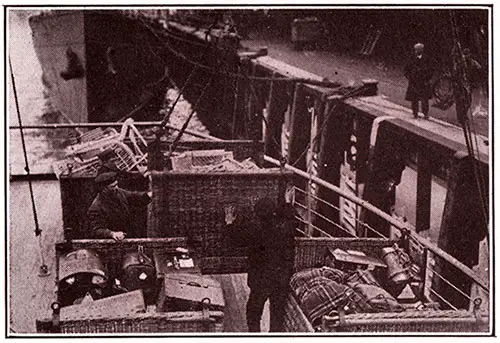
Landing Passenger's Luggage at Quayside at Fishguard, 1913. GGA Image ID # 17933e0290
Each steamship company has rules relating to baggage, which should be carefully observed. The amount carried free is usually eighteen cubic feet, but this amount varies. Eighteen cubic feet mean about 200 pounds.
The remarks relating to baggage may be regarded as a kind of composite picture of the subject, and the information given should not be considered final. Always address the companies for detailed information. They will cheerfully supplement this with written directions if necessary.
When you pay for your steamer ticket, always ask for baggage tags, which are freely provided by the steamship company. Be sure that the right labels are attached to every piece of baggage. Use the stateroom tag for the steamer trunk and other articles of baggage which are to be placed in the staterooms.
If you are likely to want access to a trunk during the voyage, a "Wanted" label should be put on. Baggage which is not likely to be called for during the voyage is put on hold, using the "Hold" or "Not Wanted" label.
Special labels for each port are furnished, and care should be exercised in using the proper tags in order to avoid delay or loss.
Labels on trunks and cases should not be placed on the sides or on the top, but on both ends. The name of the passenger should also be marked legibly and durably on every piece of baggage apart from the label in case the tags are lost or damaged. Baggage may be sent to the pier a few days in advance of the sailing day.
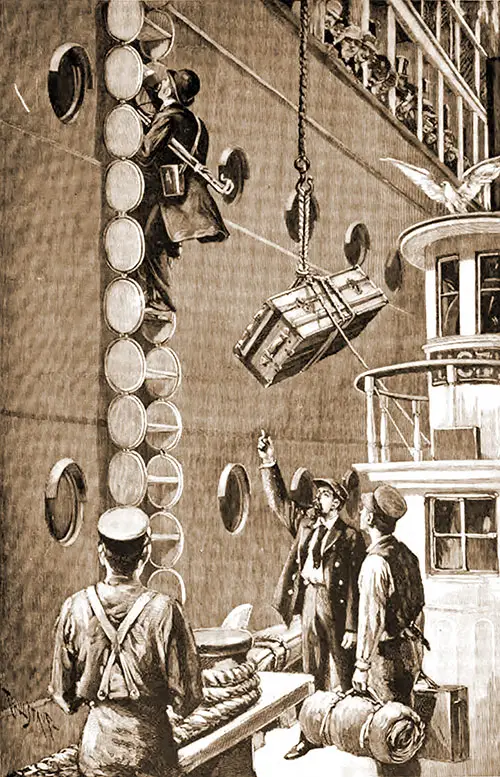
Hoisting Up a Steamer Trunk for a Late-Arriving Passenger, The Ship's Company, 1897. GGA Image ID # 179383dd9a
Passengers arriving in New York by train may have their trunks checked to the pier by the baggage express agent, who passes through the train shortly before its arrival. All baggage must be claimed at the pier prior to boarding the steamer on the day of sailing.
Passengers are advised to keep all small pieces of baggage, such as handbags, satchels, etc., in their possession and take them on board personally on embarkation.
The expenses connected with the transfer of baggage from the pier to the steamer or from the baggage depot to the lighter or tender, thence on board the ocean steamer and from it to the delivery room, are borne by the company.
All matters with reference to bag-gage must be arranged with the baggage master on the pier; other employees of the company are not permitted to accept commissions to attend to any matters which do not pertain to their duties and positions.
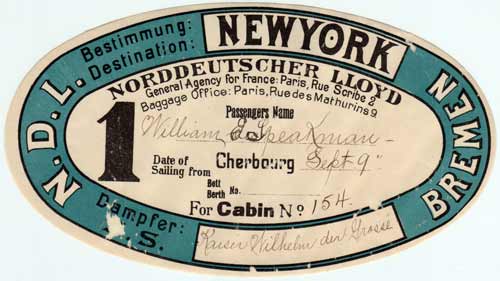
Baggage Sticker for a Voyage of the SS Kaiser Wilhelm der Grosse of the Norddeutscher Lloyd, Bremen to New York, 9 September 1901. The Ship was in Service from 1897 to 1914. GGA Image ID # 17939e55fd
On some lines, the checking system used by American railways has been introduced to facilitate the transportation of baggage between New York and ports of call of the steamers, as well as inland points in Europe, London, Paris, Hamburg, to which passengers are forwarded by special trains.
To effect this through checking, a perforated check is used, one part a which is fastened to the baggage, and the other given to the passenger.
Hand Baggage
If possible only hand baggage should be taken by the traveler on the Continent, as in many countries nothing will be carried free in the baggage vans, as is the case with Italy, Switzerland, and Germany. Austria and Denmark allow 55 pounds free; France and Spain 66 pounds; Belgium and Holland 55 pounds on through routes only, while in England 150 pounds on each first-class ticket, and 100 pounds on third-class tickets, is allowed.
The baggage is charged by weight where nothing is allowed, and no definite rates can be given. A receipt is given for all money paid for the transportation of baggage, and this corresponds to our check.
It should be borne in mind that a passenger cannot claim more space for his hand-baggage than is comprised in the space under his seat or in the netting overhead; it should, therefore, be condensed as much as possible.
As a rule, the seat space does not exceed 22 inches in width.. On the mountain railways, there are frequently no racks for hand baggage.
If possible, the tourist should only take a small valise or suitcase that he can carry in hand. It should be of simple construction so that it can be opened in an instant for Customs examination.
All baggage should be marked with the owner's name and place of destination in full and fastened with case locks. Padlocks and straps are objectionable, being liable to damage or removal.
Canvas coverings are also undesirable, their removal often leading to the loss of the package. Jewelry and other valuables should not be placed in registered luggage.
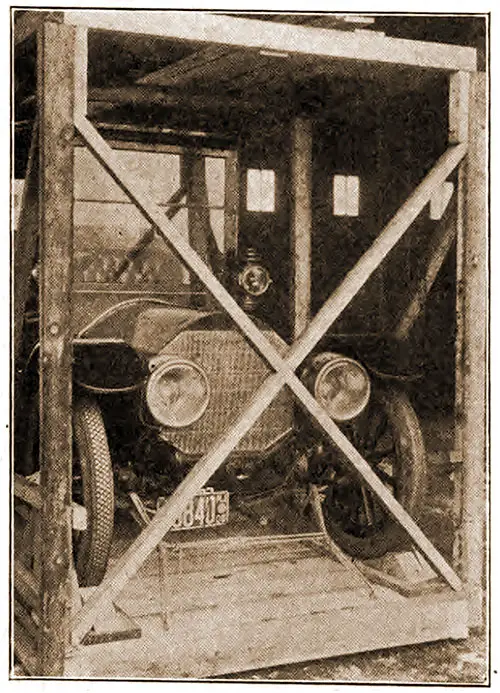
Boxing the Automobile for Shipment Abord a Steamship. GGA Image ID # 17938e513b
EXCESS BAGGAGE
Each cabin passenger, including each child who pays half fare, is entitled to the free carriage of hand baggage and of a stateroom trunk about 36 inches in length, 22 inches in breadth, and 14 inches in depth, or of a similar piece of baggage about that size, to the place of destination.
This applies to German lines only. For each piece of additional baggage, not exceeding 18 cubic feet in measurement and 200 lbs. in weight, the following charges are made :
- Between New York and Hamburg, Cherbourg, Bremen, Boulogne S. Mer, Southampton, Plymouth, Gibraltar, Genoa or Naples: eastbound, $1.00, or westbound, M. 4, Frs. 5, 4 Sh., or Lire 5.
- Between New. York and Paris via Boulogne S. Mer: eastbound, $2, or westbound, M: 8, or Frs. 10.
- Between New York and Paris via Cherbourg: eastbound, $3, or westbound, -M. 12, or Frs. 15.
- Between New York and London via Plymouth or Southampton: eastbound, $2, or westbound, M. 8, or 8 S h.
- Between German and French or English Channel Ports, also between French and English Channel Ports, also between the Italian Ports of Genoa and Naples: $0.50, or M. 2, or Frs. 2.50, or 2 Sh., or Lire 250.
If the measurement or weight limit above stated is exceeded, the charge will be increased proportionately two, three, or more times the above rate.
The liability of the company for damage or loss, as well as for delay in delivery, and any responsibility which may legitimately attach to the shipowner for the baggage, is limited to $100.00 for each first cabin trunk; $50.00 for each second cabin trunk; $40.00 for each third cabin or steerage passenger's baggage.
If the value of the baggage exceeds these amounts, and greater compensation is desired in case of loss or damage, the value and contents of each package must be declared to the baggage master before boarding the steamer, and a charge of 1 percent on the excess value must be paid.
The company does not assure responsibility for loose baggage, property, or personal effects of any kind which remain in possession or care of the passengers during the voyage.
Claims regarding damage or loss of baggage must be made to the company's representatives immediately after arrival of the steamer at the port of destination.
ARTICLES NOT ACCEPTED AS BAGGAGE
Only regular baggage is accepted at the rates stipulated. For merchandise and packages of a commercial shape, if accepted by the company for transportation as baggage, double the highest rate of the company's tariff is charged with a minimum charge of M. 20, Frs. 25, westbound, or $5.00 eastbound, per piece.
Merchandise, money, valuable documents or articles value will not be accepted as baggage, and the company will accept no responsibility for such articles when shipped as baggage.
BAGGAGE INSURANCE
Steamship companies' liability is limited to the amount specified on the steamship contract ticket; marine insurance can, however, be effected at very moderate rates, and the conditions are so favorable that it is surprising that more passengers do not avail themselves of this opportunity.
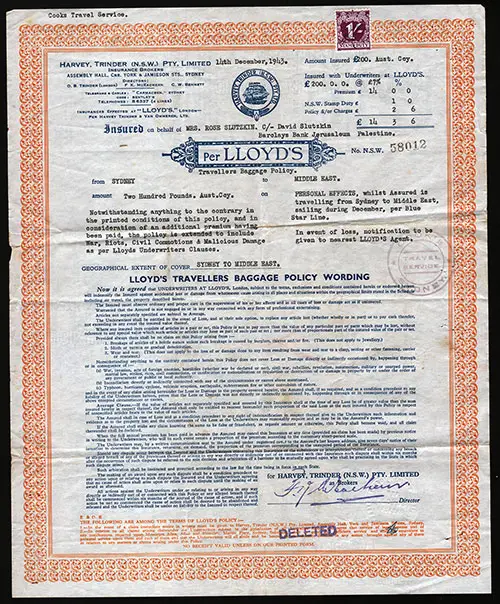
Baggage Insurance Policy Certificate Issued by the Lloyd's of London, 1943. GGA Image ID # 1792d3f2b3
Insurance can be effected at any steamship company's office. Insurance against burglary can also be secured, and many insurance companies issue clothing policies which cover all kinds of contingencies.
The following information relating to baggage insurance is about the same as the regulations of all other companies and may be considered as typical:
The Company's liability for baggage is strictly limited, but arrangements have been made whereby passengers can have the same insured against loss by sea or land, including risk of fire, breakage, theft, or pilferage, from the time the baggage is received by the lines or their Agents at port of departure, and until delivery at destination.
Crockery, China, Glass and Pictures free of breakage unless caused by the vessel being stranded, sunk, burnt, on fire, or in collision
The Company strongly recommends passengers to insure their packages whenever practicable, as in the event of loss or damage to baggage, the companies cannot under any circumstances accept any liability beyond the amount specified on their steamer contract ticket.
Another form of insurance, known as the "'Tourist Floater," covers the loss or theft of baggage or personal effects in transit by rail or water, or loss by fire while in any ordinary repository, i. e., dwelling, hotel, storehouse, railway station, etc.
It is a desirable form of insurance owing to the limited liability of transportation companies as expressed on their tickets and sustained in the courts.
STORAGE AND FORWARDING OF BAGGAGE
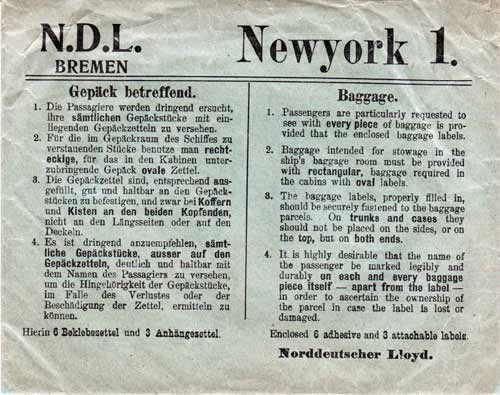
Instructions for Baggage for Passengers on Board the SS Kaiser Wilhelm Der Gross for the Voyage of 9 September 1901. GGA Image ID # 1793cc0007
It is possible to leave the steamer trunk at one port and have it forwarded to another in anticipation of the return voyage. Transportation charges and storage must, of course, be paid.
The purser or baggage master on the vessel will give full information as to the proper method to pursue. In case the traveler is to sail from another port, the keys of the trunks must be left with the proper officials.
Always write to the office of the steamship company at the port of departure when baggage is forwarded, in order that the baggage may be gotten out of storage, and so that it may be placed on the vessel without loss of time.
It is wise to ask the steamship company to acknowledge the receipt of such instructions, as nothing is worse than to have a trunk miscarry at the wrong time.

The Baggage Room at Ellis Island, 1902. GGA Image ID # 1792df4ed0
Checking of Baggage in Bond
The principal railroads have inaugurated a system of handling baggage in bond to and from points in Canada and Vancouver; also to San Francisco for immediate shipment from there to the East.
Baggage intended for immediate exportation to these points, arriving at the Port of New York, is forwarded in bond, and no examination is therefore necessary on the part of the United States Customs officials.
Ordinarily, under this plan, baggage will go forward on the same train with the owner; no charge is made for the service except for wagon transfer of such baggage from the company's piers to the railroad station.
The uniformed agents of the railroads meet all incoming steamers and will make all arrangements for the checking and bonding of baggage upon request.
A similar system is in operation in Europe for the transfer of baggage between cities having Custom-house facilities. Baggage may be forwarded by fast or slow freight. Slow freight is pot recommended as it takes too much time.
Passengers traveling to either Cherbourg or Hamburg and whose ultimate destination is London can arrange with the baggage master on board steamer to have their surplus baggage landed at Plymouth for the purpose of being forwarded by the local Plymouth agents for storage.
Such baggage will be examined by the Customs authorities at Plymouth, and duty, if any, charged on articles subject there-to, viz., wines, spirits, perfumery, tobacco, cigars, cigarettes, etc.
In forwarding baggage, all incidental expenses, including customs duty, porterage, dock dues, cording, are payable by the passengers. Storage rates average about twenty-five cents per month for each piece not exceeding 100 pounds.
This rate does not always cover insurance, which should be arranged for specially. Local transfer charges vary in different places, hut average about twenty-five cents for each piece.
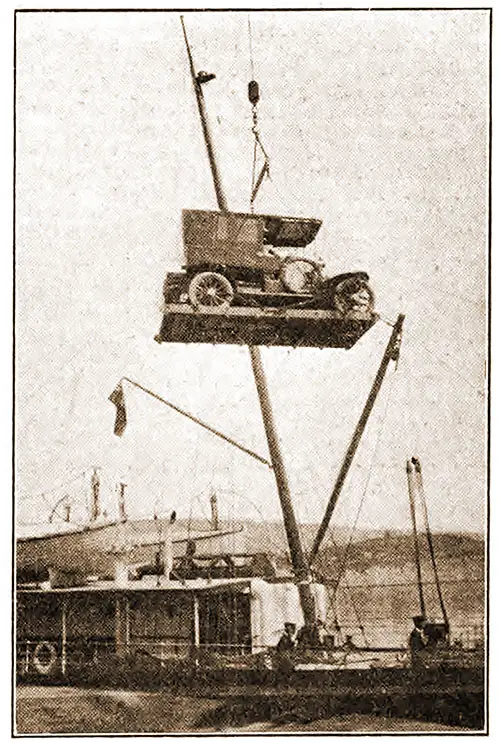
Swinging a Touring Car On Board a Steamship at Folkestone, England. GGA Image ID # 1793e3d8f9
Transporting Valuables on Steamships – 1910
Steamship companies are not responsible for money, jewels, or other valuables of passengers. They should not be kept in the staterooms, but should be given to the purser for safe-keeping in the safe provided; he will receipt for the same.
On some vessels, safe deposit vaults are provided, giving the passengers the same protection they would have at the bank or safe deposit company at home.
However, it should be remembered that the company accepts no responsibility for loss or damage, however arising. The passengers can protect themselves by insurance.
Passengers are generally warned against keeping valuables in their staterooms. It is customary to place same in the care of the purser.
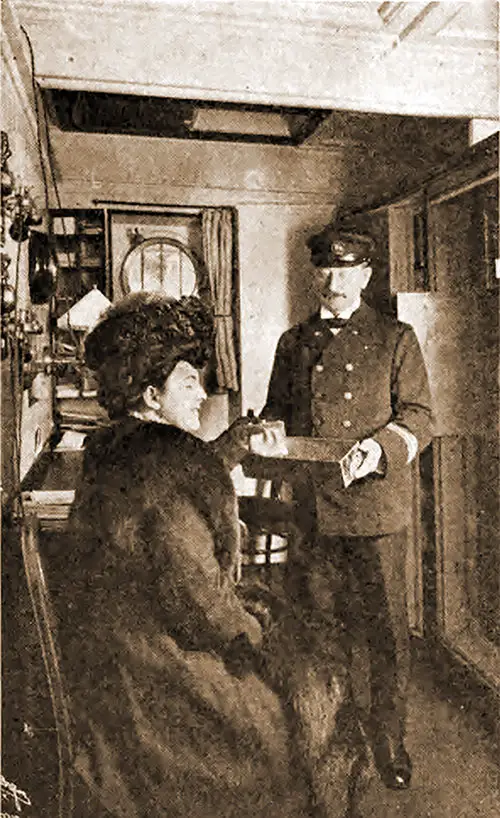
Purser Assists a Passenger in Storing Her Valuables in the Purser's Safe Deposit Vault. GGA Image ID # 1794148e52
Steamship companies make no charge for this service, and they accept no responsibility for loss or damage. (Issue 89, 1920)
In a Supreme Court, New York, Appellate Division, First Department, November 1905, Hart v North German Lloyd SS Company,
Steamship — Carrier and Passenger — Articles of Apparel Stolen From Stateroom.
Where the steward of a ship entered a passenger’s stateroom through the door left open by the passenger and found a porthole also open, and after seeing valuables of the passenger lying on a sofa, failed to close the porthole and lock the door, and afterwards the valuables were taken from the stateroom, the negligence of the steward, and not that of the passenger, was the cause of the loss for which the steamship company was liable.
Specie and Valuables, usually in charge of the pursers of the steamships, must be taken in possession of by discharging inspectors as soon as possible after they first go on board the vessels.
The special place or room where such specie and valuables are deposited and the safe or the packages containing the same must be locked with custom-house locks, or otherwise secured, until delivered on a permit from the proper customs officers. (US Article 1464, 1908)
